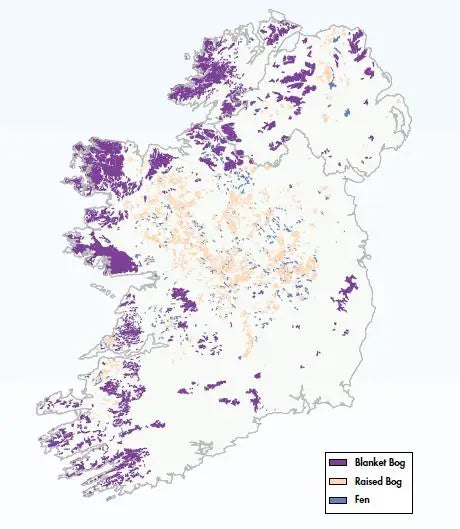
Ireland’s Living Tradition: The Last Peat Bogs Still Harvested for Turf
Share
In the misty stillness of Ireland’s countryside—north and south alike—the soft, steady rhythm of turf cutting continues in pockets of land that feel untouched by time. These are the last remaining peat bogs still used for harvesting turf, where the smell of a turf fire and the sight of drying footings speak of a tradition both humble and deeply rooted.
What is Turf, and Why Does It Matter?
Turf—known elsewhere as peat—is an organic fuel formed over thousands of years in boglands. For generations across Ireland, turf has been an essential part of rural life: providing heat, cooking meals, and anchoring the rhythms of the year.
But it’s more than fuel—it’s part of the Irish way of life. A turf fire doesn’t just warm a home—it warms a culture.
The Craft of Turf Cutting
Turf cutting is a seasonal and skilled practice. Traditionally carried out with a sléan, a type of narrow spade, turf is sliced into long blocks, stacked in “footings” to dry, and eventually brought home for burning. In more recent years, some families use small machines to assist, but the methods still reflect the heritage.
From April to September, bogs come alive with quiet industry—stacks appearing along boreens and fields, filling the air with the rich, smoky scent of the land itself.
Where Turf Lives On: North and South
Turf cutting continues today in small communities where families maintain ancient rights to harvest for personal use. These areas represent the living memory of bogland culture, especially in the more rural counties.
In the North of Ireland:
The Sperrin Mountains (Co. Tyrone)
Blanket bogs stretch across the highlands, where turf is still cut by families and smallholders. Look out for neatly stacked footings near Cranagh, Greencastle, and Plumbridge.
Moorlough and Clogher Valley (Co. Tyrone & Fermanagh)
Low-lying bogs where older traditions persist—some handed down over centuries. It’s common to see stacks drying on the roadside near Augher or Fivemiletown.
Garron Plateau (Co. Antrim)
One of the most scenic upland peatlands, with a view stretching over the north coast. While mostly conserved, small-scale domestic cutting continues in places near Waterfoot and Glenariff.
Belleek and Garrison (Co. Fermanagh)
Along the border near Donegal, turf traditions remain strong, with families on both sides continuing their seasonal work.
In the Republic of Ireland:
County Offaly – Known as the “heart of the bog”, where cutting continues on private lands near towns like Ferbane and Clara.
County Roscommon – A stronghold of turf heritage, especially in areas like Ballaghaderreen and Castlerea.
County Mayo & Connemara (Galway) – Remote mountain bogs near Ballycroy and Recess, where turf is still stacked in traditional forms.
County Donegal – Blanket bogs in the west and north of the county support active turf traditions, especially near Glenties, Ardara, and the Blue Stack Mountains.
Turf: Fuel, Family, and Familiarity
A shed full of turf is more than stored heat—it's a symbol of hard work, self-reliance, and connection to the land. In both the North and South, people still come together each season to cut and turn the turf, sharing tea, stories, and labor under big skies.
Children learn from grandparents, friends lend a hand, and neighbors admire a well-built footing. The experience is more than practical—it’s communal and cultural.
The Hearth’s Heartbeat
Few things feel as comforting as the crackle of a turf fire. The smoky scent rising from a chimney in Tyrone, Mayo, or Donegal isn’t just nostalgia—it’s a living tradition. It brings warmth not only to bodies, but to memory. Around that fire, Irish songs are sung, stories passed down, and silence shared with meaning.
A Tradition Worth Holding Onto
While modern Ireland moves swiftly, the turf bogs of Tyrone, Fermanagh, and Connemara move slowly—by season, by hand, by heart. In these last working bogs, the past and present live side by side.
They remind us that not everything needs to be fast to be valuable. Some things, like turf, are best cut slow and burned gently.
